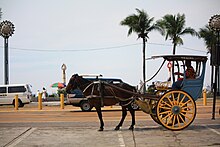| Kalesa | |
|---|---|
  | |
| Application | Transportation |
| Powered | No |
| Self-propelled | No |
| Wheels | 2 |
A kalesa (Philippine Spanish: calesa), is a two-wheeled horse-drawn carriage used in the Philippines.[1][2] It is commonly vividly painted and decorated.[3] It was a primary mode of public and private transportation during the Spanish colonial era of the Philippines, though in modern times, they largely only survive as tourist attractions, such as in Vigan, Ilocos Sur.
Kalesas have other names based on the number of passengers they can seat. Small kalesas which can carry one or two passengers in front-facing seats are known as karomata or karumata. Larger kalesas which carry freight or up to six or more passengers in side-facing seats are known as karitela or karetela (also tartanilla in Cebu). However, these terms have become interchangeable over time. Four-wheeled carriages are differentiated as karwahe.
- ^ Cite error: The named reference
Montefalconwas invoked but never defined (see the help page). - ^ Cite error: The named reference
smithwas invoked but never defined (see the help page). - ^ Chiu, Imes (2008). The Evolution from Horse to Automobile: A Comparative International Study. Cambria Press. pp. 224–229. ISBN 9781604975468.
© MMXXIII Rich X Search. We shall prevail. All rights reserved. Rich X Search
